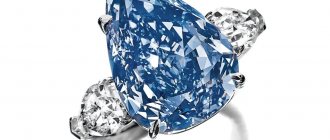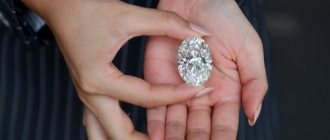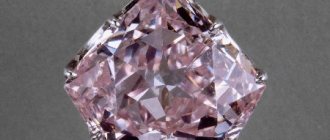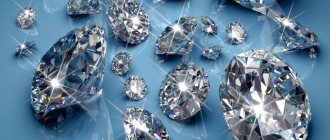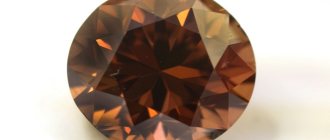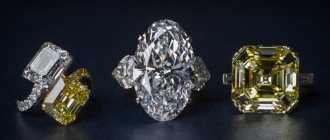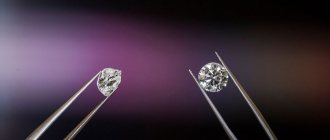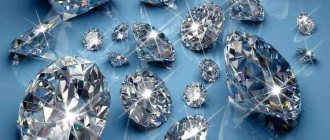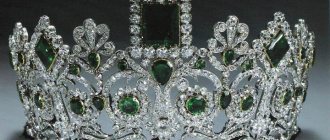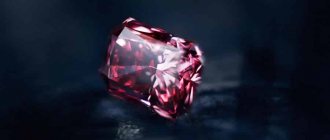Culture
Diamond, whose name from Greek means “indestructible”
, is formed at a depth of about 200 km underground under enormous pressure and heat.
They come to the surface during volcanic eruptions, or are mined in old volcanic zones. The diamond is between 990 million and 4.2 billion years old
.
A diamond is a diamond that has been cut in such a way as to highlight the natural brilliance of the stone.
To find out how perfect a diamond is, it is assessed according to the 4 characteristics of the “4Cs”
: carat, color, cut and clarity.
A carat is used as a unit of measurement for the weight of a gemstone and is equivalent to 1/5 of a gram. The higher the carat of a diamond, the higher its price.
Several outstanding diamonds have gained worldwide fame due to their history.
The biggest diamonds
Diamond "Great Mogul"
"Great Mughal" was named after Shah Jahan, the ruler of the Mughal Empire who built the Taj Mahal. The diamond was discovered in the Golconda diamond mines in the 1650s, and its weight of 787 carats made it the largest diamond in India.
.
The diamond was cut into a rose-shaped diamond with a bluish hue. However, the stone was lost first during the war with Persia, and then after the assassination of Nadir Shah, who acquired it in 1739.
After 1747 the "Great Mogul" disappeared
, and was never seen again, at least not in his original form.
There are many versions regarding the fate of this diamond. It is believed that the famous Orlov diamond was subsequently made from it, but the secret has not yet been revealed.
Diamond Cullinan
The Cullinan I was the largest diamond in the world until the Golden Jubilee was discovered.
It was made from a fragment of the largest diamond in history - the Cullinan diamond weighing 3106 carats.
. The diamond, also called the “Great Star of Africa,” was found on January 26, 1905 in South Africa. It was named after the mine owner, Thomas Cullinan.
The Cullinan was given to King Edward VII on his birthday. The cutting of the largest diamond was entrusted to the famous cutters, the Assker brothers from Amsterdam. Since the diamond had cracks, it could not be made into one large diamond
.
Cutting maker Josef Asker spent several months preparing to make one single sure blow on the stone, which would split it along natural cracks. The excitement was so strong that after the ceremonial blow, Asker lost consciousness, but the diamond split into two halves.
The largest of the nine fragments received,
the Cullinan I diamond, adorns the scepter of the British Queen
, and can be seen in the Tower of London with the rest of the British crown jewels.
Diamond "Golden Jubilee"
The Golden Jubilee is the largest cut diamond in the world
. The golden-brown diamond supplanted the Great Star of Africa and was discovered in 1980 at the Premier mine. For a long time it remained unnoticed, and it was given to the famous cutter Gabriel Tolkowsky to test new cutting tools.
Much to the surprise of many, the Golden Jubilee turned out to be a real treasure weighing 545.6 carats.
(up to cut 755.5 carats).
The resulting diamond was blessed by Pope John Paul II, the Supreme Buddhist Patriarch and Grand Imam of Thailand. It was presented to the richest king in the world - the King of Thailand
while celebrating his anniversary.
Diamond "Orlov"
"Orlov" is considered the largest diamond of the Diamond Fund
Moscow Kremlin. The origin of the stone, which has the shape and proportions of half a hen's egg, dates back to the 18th century in southern India. Although part of the Orlov's history has been lost, it is believed that it once served as the eye of a statue in an Indian temple.
The stone was stolen by a Frenchman who converted to Hinduism and even became a novice in the temple to carry out his plan.
As a result, the diamond was sold to Count Orlov, who presented it to Catherine II
.
The Orlov is a pure white diamond with a bluish-green tint and is very rare as it has retained its original Indian rose cut.
Cullinan II
Cut weight: 317.4 carats
Cullinan II, also known as the Second Star of Africa, is the second largest stone carved from the original Cullinan. The diamond is one of the central elements of the Imperial State Crown (located under the large Black Prince Ruby), which is used during the coronation ceremony of the British Monarchy. The Cullinan II is a cut diamond with 66 facets. It has a number of scratches and minor imperfections.
The most expensive diamonds and diamonds
Diamond "Sancy"
The most famous owner of the Sancy diamond is King Henry III
, who purchased the stone from his attorney Nicolas de Sancy. The stone served as a beret decoration to cover the king's premature baldness.
According to legend, the messenger who was supposed to deliver the stone was killed. However, the faithful servant kept the stone, which, after opening, was found in his stomach.
The diamond was sold to King James I of England and then to Cardinal Mazarin, who left it to King Louis XIV. During the French Revolution, it disappeared along with the Regent Diamond and the Hope Diamond.
As a result, Sancy was sold to the Louvre for a million francs
, and is still stored there. Its price has not been established, but it is considered priceless.
Diamond "Kohinoor"
The Kohinoor Diamond or the Mountain of Light has a long history.
. The first mention of it appeared in 1304, when King Babur discovered a diamond, and since then it passed to all the rulers of the Mughal Empire - a state in the modern territory of India and Pakistan.
Hindus, Mughals, Persians, Afghans, Sikhs and the British fought desperately for the right to possess it throughout history. Almost all Kohinoor owners suffered an evil fate: death, poisoning, betrayal
. From the once huge stone of 793 carats, 105 carats (21.6 grams) remain.
In 1850, the diamond was given to Britain's Queen Victoria, who wore it as a brooch for a long time. The famous Kohinoor was worn by Queen Alexandra, Queen Mary and is now in Queen Elizabeth's crown.
at the Tower of London. Its price has not been established, but it is considered priceless.
Diamond "Hope"
Perhaps the most famous diamond in the world is the Hope Diamond. No one knows how large the stone was before it was cut, where it was found, or who gave it its original shape. It was first mentioned by the French merchant Jean-Baptiste and sold to King Louis XIV.
Some experts believe that it was stolen from a statue of the ancient Indian goddess Sita
. It passed to King Louis XVI and Marie Antoinette, then was stolen and reappeared in 1829. Banker Henry Hope purchased the diamond and the stone is named after him.
The subsequent numerous owners of "Hope" suffered an unfortunate fate
: violent death, illness, loss of a child and accidents. The Doomstone gained the reputation of being cursed, and it was believed that everyone who touched it would die a terrible death.
Since 1958, the diamond has been in the Smithsonian Institution
in USA. Its price is $350 million.
Kohinoor
Glass copy of the diamond after recutting
Weight: 793 carats Cut weight: 105.6 carats.
Kohinoor is perhaps one of the most popular as well as controversial diamonds on earth. Since its discovery, most likely in the 12th century, at the Kollur mine (located in Andhra Pradesh, India), the Kohinoor has been part of many historically significant crown jewels and ornaments.
In 1849, the diamond came into the possession of the British Empire and was reduced from 191 carats to its current size. It is currently on display in the Jewel House of the Tower of London.
For decades, the Kohinoor Diamond has caused diplomatic controversy between India, Pakistan, Afghanistan and Britain, all of whom claim to be its rightful owners.
Regent's Diamond
The Regent Diamond, also known as the Queen of Hearts, was found in 1698 by a slave in a mine who eventually paid for it with his life. The captain who found a hidden diamond killed a slave, sold the stone weighing 410 carats
to an Indian trader and then to a British businessman, Thomas Peet, in 1701. It was reduced to 141 carats.
The Regent Diamond is considered one of the most beautiful in the world. It is white, but with a subtle bluish tint that not everyone sees. The diamond became the adornment of Marie Antoinette, Napoleon, King Louis XVIII, Charles X and Napoleon III
. Now it is in the famous Louvre Museum.
Diamond "Millennium Star"
The Millennium Star is the 10th largest and 2nd largest D color diamond.
. Before cutting it weighed 777 carats, and after it weighed 203 carats. A majestic diamond without external or internal flaws was of exceptional purity.
The stone was purchased. It took more than 3 years to give the diamond its classic pear-shaped shape using lasers. "Millennium Star" with 11 blue diamonds
was mined from the Premier mine in South Africa. In 2000, these amazing diamonds from the Millennium collection were presented at an exhibition in London.
Diamond Taylor-Barton
The 241-carat diamond, from which the famous diamond was later made, was found in the Premier mine in South Africa. The famous jeweler Harry Winston cut the stone, which became pear-shaped and weighed 69.42 carats. A stone of amazing transparency and beauty became the first diamond sold at auction for more than a million dollars.
.
Its buyer was Richard Burton, who bought it for his wife, the famous actress Elizabeth Taylor. Elizabeth could wear such a treasure only a few times a year under the protection of guards, and the first time she appeared with it was at the celebration of Princess Grace's birthday in Monaco.
When the actress divorced Barton, she sold the diamond for $5 million and used the proceeds to build a hospital in Botswana. It is believed that this is the first time that a diamond brought anything other than misfortune.
.
"Incomparable"
This bright golden diamond with an irregular triangular shape has an amazing history. It was found quite by accident by a little girl from the Congo in 1980. She was playing near the long-abandoned diamond mines, and the shine of the stone caught her attention. At first, her find weighed as much as 890 carats, but as a result of cutting, it was halved and began to weigh only 407 carats (81.5 grams).
The first time “Incomparable” was put up for auction at Christie’s, where it was immediately sold to Geneva for 12 million dollars, later they tried to sell it for 15 million, and in 2009 it was exhibited in a museum in Ontario. Today, “Incomparable” flaunts as the center of a necklace made in rose gold, framed by almost a hundred smaller stones.
"The Little Prince" (Princie)
This diamond is also pink, but much less intense, more of a smoky color. This third largest pink cushion cut diamond weighs 34.65 carats. It was found in India about 300 years ago and belonged to an Indian vizier. The stone received its modern name in the 60s of the 20th century, when it was bought by the jewelry house Van Cleef & Arpels. In honor of the purchase, a reception was organized, at which the name “Little Prince” appeared in honor of the little son of the Maharani, the princess of the Indian principality of Baroda.
In 2013, this stone was sold at auction to an anonymous buyer for a record $39 million. Today, if sold, it will cost more than 40 million.
"Red Cross"
This diamond was named due to the fact that after cutting the outline of a Maltese cross appeared in the stone. They found it in a mine that belonged to the same De Beers in 1901. The weight of the find was 205 carats, which is 41 grams. It is canary yellow in color and cushion-shaped. In addition to the mysterious cross, the stone has another feature - it can accumulate light energy and then glow in the dark.
At the beginning of the 20th century, it was donated to the Red Cross, which sold it at auction for 10 thousand pounds, spending the proceeds on the improvement of hospitals. Today it is unknown who exactly owns this unique stone.
De Beers
This not too bright yellow diamond was named after the mine where it was mined. Its weight is 234 carats or 47 grams (before cutting it was almost 430 carats). In 1921, the Maharaja who ruled India in Patiala became its owner. The jewelry house of Cartier made for his collection a necklace of 2,930 diamonds, in the center of which was placed a luxurious De Beers. After the death of the Maharaja, this thing disappeared. In 1998, parts of it began to appear at various auctions.
The House of Cartier bought them all in order to restore the product, but its largest stones, including De Beers, were not found. Today, the Jewelry House has recreated the Patiala necklace, replacing the missing stones with artificially grown crystals in the hope of one day replacing them with the originals.
"Annenberg"
Last on our list of the world's largest diamonds is the 32-carat Annenberg. Of course, knowing how much the largest diamond in the world weighs, it is difficult to call “Annenberg” large, but such stones are extremely rare, which is why they are all given names.
"Annenberg" has a square shape, emerald cut, impeccable clarity and transparency. The stone got its name thanks to its owner - Lee (Eleanor) Annenberg bought it for her 90th birthday in 2007. She was the wife of the famous diplomat, collector and philanthropist Walter Annenberg.
Jeweler David Webb created a noble setting for the stone - it became the central part of the platinum ring. On the sides, the “Annenberg” is decorated with two smaller pear-shaped diamonds. After the death of the owner, the ring was put up for auction and in 2009 was purchased for more than 7 million dollars.
Now you know what the largest diamond in the world is, how many carats it weighs, which one is the most expensive, and why they are so valuable.
"Centenary"
In 1986, a colorless diamond of 599 carats was found. After cutting, its weight was 273 carats or almost 55 grams. It is also famous for its purity - it is assigned grade D, one of the highest for colorless diamonds. To cut it, it took several of the best jewelers, engineers, electricians and the work of a special security service.
In 1986, a colorless diamond of 599 carats was found. After cutting, its weight was 273 carats or almost 55 grams. It is also famous for its purity - it is assigned grade D, one of the highest for colorless diamonds. To cut it, it took several of the best jewelers, engineers, electricians and the work of a special security service.
“Drop of the Sun” (Cora Sun-Drop Diamond)
Despite its small size (compared to the giants, it weighs very little - 110.3 carats or 22 grams), it is famous for its properties. “A Drop of the Sun” is considered a record in its class. This yellow pear-shaped diamond was formed approximately 2 billion years ago.
It received its name for the bright yellow tint that appeared in the stone due to nitrogen inclusions in the diamond structure. In general, such a bright color is not typical for natural diamonds, since they are usually transparent or only slightly tinted. It is also important that the nitrogen that gives the color is distributed so evenly in the stone that it does not prevent it from being transparent and clean.
Considering the considerable weight of the stone, this is its unique characteristic. This very purity and color provided him with fame. Even though it is not the largest diamond in the world, the photo of this stone explains its fame. In 2011, it was sold to an unknown buyer for $11 million.
Millennium Star (203.04 carats)
In many respects it is simply impeccable. The diamond was discovered in 1989 in the Mbuji-Mayi region of Zaire. It took more than three years to bring it to its current form. “ Millennium Star ” was first shown to the world in October 1999, hence the name.
It is interesting that in terms of their uniqueness, diamonds are comparable only to human fingerprints, because on the entire planet you will not find two completely identical stones. And diamonds are cut according to certain standards, which may change depending on fashion trends in jewelry.
"Jubilee"
The next heaviest diamond, mined in 1895 in Africa, today weighs 245 carats (49 grams) and is cut into a cushion shape. Initially, this colorless diamond was named after William Reitz, the head of the Orange Republic, which soon became part of South Africa. In 1897, it was renamed “Jubilee”, because in that year it was cut and in the same year the diamond, 60th anniversary of Queen Victoria was celebrated.
The diamond was seen at an exhibition in 1900, and its first owner was an entrepreneur from India. After his death, his heirs sold the stone, and today its owner donated it for exhibition at the Washington Museum.
